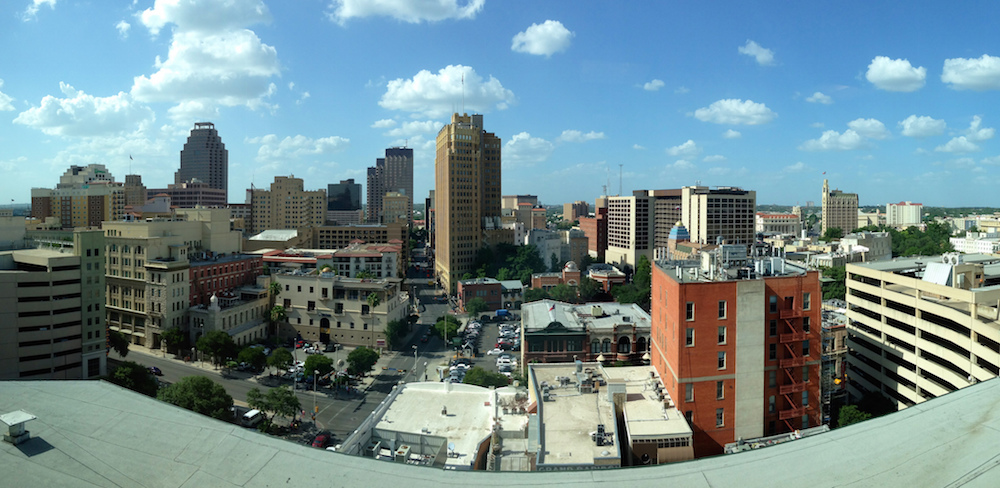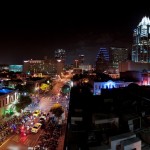
Recently, the breakfast-taco brouhaha between the Texas cities of Austin and San Antonio got particularly heated. Now, we’ve got a blogger for The Huffington Post making a dubious claim: San Antonio is the “new Austin.”
In a recent Huffington Post travel piece about San Antonio, blogger Sidonie Sawyer, who brands herself as a “Franco-American hybrid journalist,” declares that San Antonio “is now baptized the new Austin.” What???? We here at LawnStarter, an Austin-based startup that does business in San Antonio, must have missed that baptism.
Sawyer, who says she spent 24 hours in the Alamo City, offers this faulty reasoning for the “new Austin” title: “Many large IT companies” have chosen San Antonio over Austin to take advantage of less traffic, more space, lower prices and more workers.
Where’d you get that information, Sidonie? Perhaps you were inspired by a December 2015 post we found on Bisnow, a website that covers the real estate industry. The headline: “Why San Antonio is stealing tech activity from Austin.”
Here’s the opening sentence of the Bisnow post:
Tech companies are starting to choose San Antonio over Austin, creating a new tech hub, Kennedy Wilson managing director Ernest Brown tells us.
Nowhere in the Bisnow post does writer Catie Dixon mention anything about “many” large IT companies choosing San Antonio over Austin.
The San Antonio Express-News teed off on the “new Austin” claim.
Getting back to Sawyer’s post, Austin does have more traffic and higher prices (at least in terms of housing) than San Antonio does. We’ll admit that.
As for the more-space comment, we’re assuming Sawyer meant office space rather than land. According to real estate giant CBRE, San Antonio has more office space available than Austin does. During the first quarter of 2016, the office vacancy rate in the San Antonio market stood at 16.8 percent, compared with 10.1 percent in the Austin market. Furthermore, the San Antonio space is cheaper — an average of $21.12 per square foot during the first quarter of 2016 versus $32.65 per square foot in Austin.
And regarding the presence of workers, the San Antonio area’s unemployment rate was slighter higher in February 2016 (3.5 percent) than the Austin area’s (3.1 percent). In other words, about 39,600 residents of the San Antonio area were unemployed that month, compared with 33,300 in the Austin area, according to the U.S. Bureau of Labor Statistics. Based on those numbers, it could be argued that San Antonio has a bigger labor pool than Austin.
.@HuffingtonPost calls San Antonio the ‘New Austin’; we’re not convinced https://t.co/WvR03RQ0RL pic.twitter.com/PdHWrc3S5w
— Austin Statesman (@statesman) April 12, 2016
So, Sawyer appears to be right when it comes to the four factors she cites behind the supposed abandonment of the “old Austin” by tech companies in favor of the “new Austin.” Nonetheless, that doesn’t justify the “new Austin” label being stuck on San Antonio.
Yes, Austin and San Antonio are among the fastest-growing cities in the U.S. Yes, both cities are enjoying strong economic growth, including job creation. And, yes, both cities are in Texas. But Austin and San Antonio are hardly mirror images of each other. And don’t get us started on which is the best place to live. Earlier this year, U.S. News & World Report ranked Austin second on its list of America’s best places to live; San Antonio came in at No. 23.
Here’s the take on Austin from U.S. News & World Report:
About 50 people move to Austin every day, drawn to the Texas capital city’s music, outdoor spaces and cultural institutions.
And here’s the magazine’s assessment of San Antonio:
San Antonio is the seventh largest city in the United States and is as comfortable as an old pair of jeans. It offers big-city amenities and world-renowned attractions coupled with a relaxed and inviting atmosphere.
To Terrill Fischer, who’s lived in both Austin and San Antonio, the differences between the two cities are quite clear. Austin is more progressive and faster-paced than San Antonio, he says, while San Antonio is more conservative and relaxed.
“People in Austin seem to view San Antonio as a tourist town. People in San Antonio tend to view Austin as a music mecca,” says Fischer, who lives in Austin now but is pondering a move back to San Antonio.
Michael Sierra-Arevalo has lived in Austin and San Antonio.
Michael Sierra-Arevalo grew up in San Antonio and eventually moved to Austin for school and work. He now attends Yale University in New Haven, CT. Sierra-Arevalo says the most Austin-versus-San Antonio chatter he’s heard has revolved around that breakfast-taco feud.
“If there’s any real animosity, it might be resentment toward what some would consider a very fabricated, hipsterish veneer that now paints Austin, particularly its W Hotel/F1 racing/dry-cleaning-startup-app side,” Sierra-Arevalo says. “Still, anyone from San Antonio that doesn’t think the same kind of changes aren’t happening in San Antonio is sadly mistaken.”
Anyone who’d confuse Austin and San Antonio would be sadly mistaken, too. Aside from being connected by a roughly 80-mile stretch of I-35, the two cities aren’t even what you’d call distant cousins. Whatever their relationship, Austin doesn’t want to be San Antonio, and San Antonio doesn’t want to be Austin.
In terms of personality, Austin and San Antonio are miles and miles apart.
Several commenters on the HuffPo article have attacked Sawyer’s piece for the nonsense that it is.
One of those commenters, Ambrose Lerma of Austin, ripped into Sawyer: “San Antonio is not Austin. I’ve lived in both cities and they each have their own personalities. They both have much to offer but the attitudes in each city differ and each city is proud. Please don’t label a city as ‘the new’ anything.”
Lili Peña Dyer, who lives in San Antonio, also isn’t a fan of Sawyer’s “new Austin” stance.
“This article is plain stupid,” Dyer writes. “You visited fancy shopping malls and our gentriFRIED art center, Blue Star, which has been open since the late 1980s. San Antonio is NOT Austin and we are damn proud of it. San Antonio is RICH in culture. You failed in your mission. I don’t think travel writing is your future.”
We don’t think settling down in the “old Austin” or the “new Austin” is in Sawyer’s future, either.
LawnStarter has provided lawn care and landscaping in Austin since 2014. Additionally, we provide lawn service and landscaping in San Antonio, TX.
Top photo: Flickr/Roy Luck









